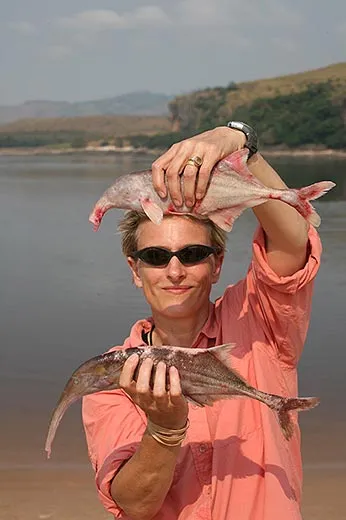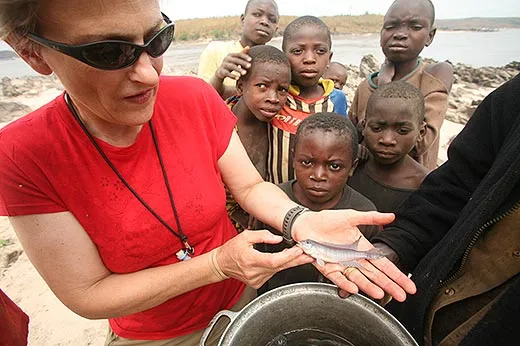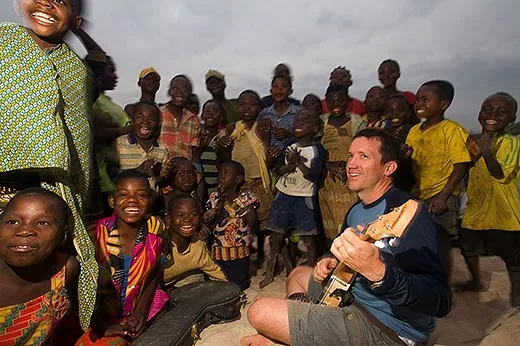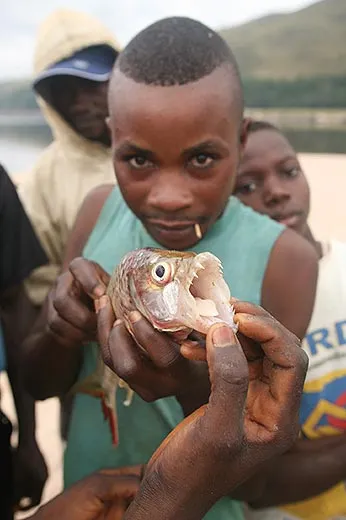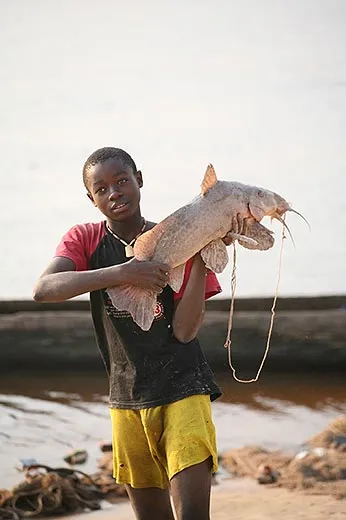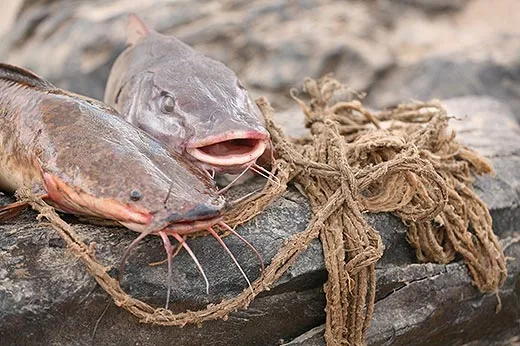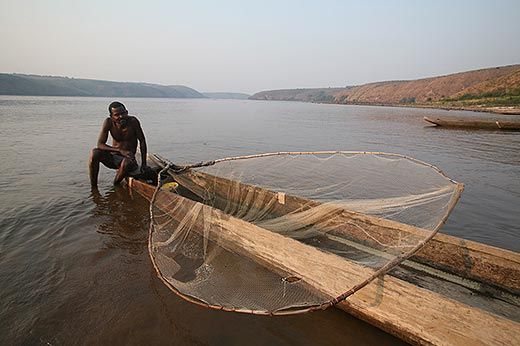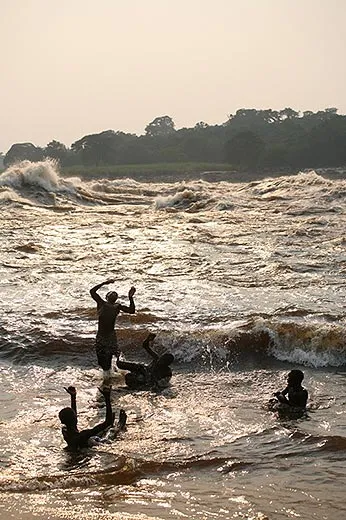Evolution in the Deepest River in the World
New species are born in the turbulence of the Congo River
/https://tf-cmsv2-smithsonianmag-media.s3.amazonaws.com/filer/lower-Congo-River-631.jpg)
Ned Gardiner, a scientist who specializes in mapping ecosystems, is fiddling with an instrument floating over the side of our wooden pirogue when the boat emerges from an eddy into the main stream of the Congo River. The transition from the still water to the turbulent flow swings the bow downstream and nearly knocks Gardiner into the water. "Almost fell into the drink, eh?" he says with a laugh, though he knows a swim here could be dangerous, even deadly. The Congo is flowing at 1.25 million cubic feet of water per second, enough to fill 13 Olympic-size swimming pools every second. Gardiner, who works for the National Climatic Data Center, in Asheville, North Carolina, is here because he thinks the Lower Congo may contain the deepest point of any river in the world.
We're in Central Africa, 90 miles west of the Democratic Republic of Congo's capital of Kinshasa and about 100 miles east of where the river drains into the Atlantic Ocean, ending its 3,000-mile run across equatorial Africa. A series of grassy hills called the Crystal Mountains rise subtly behind us. Gardiner and John Shelton, a hydrologist from the United States Geologic Survey, are plotting how water moves in such a massive flow. To do this, they brought along an instrument that floats alongside a boat in an orange, plastic vessel about the size of an elementary-school desk. The instrument maps water movement and measures the river's depth. Gardiner tried to accomplish the same thing last year with a device designed for rivers. "The signal petered out well before the bottom," he explains, his hand skimming the river's surface. "So we bought one for oceans."
We're midstream, heading from the north bank to the south, on a course directly perpendicular to the current. If we manage to keep the instrument from being swallowed by one of the 40-foot-wide whirlpools studding the flow, Shelton and Gardiner's work will produce a digital cross section of the river's currents and depth.
The Congo's power—its depth, speed and turbulence—is of particular interest to ichthyologist Melanie Stiassny of the American Museum of Natural History, one of the scientists in our expedition. She studies fish on the lower Congo and over the past decade has discovered six new species (she's working on identifying three more). The number of species known to live in the lower Congo now exceeds 300 and the river contains one of the highest concentrations of "endemism," or species found nowhere else in the world. Stiassny thinks the river's power is shaping evolution in the Congo.
New species evolve when some geographic barrier—a mountain range, an ocean, a glacier—divides a population. Animals on one side of the barrier can no longer breed with animals on the other. Each group adapts to its habitat and, over time, their genes change enough to constitute separate species. This idea dates back to Darwin's Origin of Species, published in November 1859. Stiassny and her colleagues were the first to suggest that there could be barriers within freshwater. Water, after all, is permeable for fish, right?
In 2002, Stiassny and ichthyologist Robert Schelly observed fish that suggested otherwise. They found cichlids, a freshwater fish known to evolve quickly in new environments, on one side of the Congo that were genetically distinct from similar-looking cichlids on the opposite bank. Exceptionally strong currents divided the populations. Though the river was only a mile wide, the habitats were isolated just as if a mountain range had risen between them.
We dock the pirogue on a sandbar. A crowd of locals is thronging around Stiassny. She's holding a mole-like fish that's tiny, blind and to be frank, extremely ugly. Since we arrived in the DRC two weeks ago, Stiassny has been hoping to see this fish.
"Mondeli bureau," says the fisherman who brought it to her, pointing to the fish. Stiassny smiles. The name translates as "white man in an office" and plays on the locals' vision of a computer-bound Westerner: blind, albino, stunted.
Stiassny found a similar specimen covered in gas bubbles during a collecting expedition in 2007. It had suffered from rapid decompression syndrome, or the bends. The apparent cause of death—and the fact that it had no eyes—suggested the fish had evolved in a habitat too deep for light to penetrate.
"Thank you," Stiassny says. "What a beautiful specimen." She lays the fish beside dozens of other specimens on a clear tarp. A graduate student is labeling the samples and storing them in formaldehyde-filled 50-gallon drums to be flown back to New York for genetic testing. The specimens include a 12-pound, prehistoric-looking catfish, its gills still flapping. There are tiny, oval-shaped cichlids colored like the silt, and an eel-like fish that Stiassny thinks may be a new species. The most interesting to me are a half a dozen foot-long fish with long, cylindrical snouts.
"These are elephant fish," Stiassny says. "Their jaws are at the end of their snouts so they can pick food from the gravel."
The evolutionary adaptations are apparent. Each individual was caught in a different location, and each snout is specialized to the character of the river floor in which it fed. Long and thin snouts allow fish to probe for food in deep and small-grained gravel; short and fat snouts allow them to feed on algae-caked bedrock. "Darwin's fishes," Stiassny says.
A series of mud-colored minnows caught in different locations that look identical to me excite Stiassny. "That's really where we see evolution in action," Stiassny says. "In 50 or 100 years, the fish that look the same today may well look different. We can see the start of that genetic drift."
That night, Gardiner plugs a data card in his laptop. Winged insects flock to the glowing screen, their buzzing mostly drowned out by the steady drone of the river and the occasional whoosh of its surge breaking on the beach. The computer hums while processing data. Eventually Gardiner pulls up a graph profiling the river's bed. It looks like a U—as smooth as a mountain valley carved by a glacier. The current just beneath the surface is traveling at 30 miles per hour, and the channel is 640 feet deep.
"That's the deepest point measured on a river in the world," Gardiner says. "There's no question about that."
Shelton is peering over Gardiner's shoulder, shaking his head and deciphering blue and red lines on the computer screen that represent water movement and velocity.
"Just like we thought," he says. "Fabulous stuff." He nudges a moth off the screen and points to a place in the riverbed where a long blue line indicates the current dropping vertically from a ledge into the canyon's trough.
"It's an underwater waterfall," he says, slapping Gardiner's shoulder. It's falling at 40 feet per second. Upstream of the waterfall is an eddy, the water relatively still. This point is likely habitat for the blind cichlid: calm pockets where sheering currents have trapped the fish at great depths. Deep-river specimens, like the one found today, surface only when the river surges and flushes individuals into the harsh environment of the main flow. In terms of Stiassny's hypothesis, the finding suggests that the Congo's currents partition habitat from side to side and from top to bottom—just like a mountain range.
"It shows water can be an evolutionary barrier, even for fish," Gardiner says.
